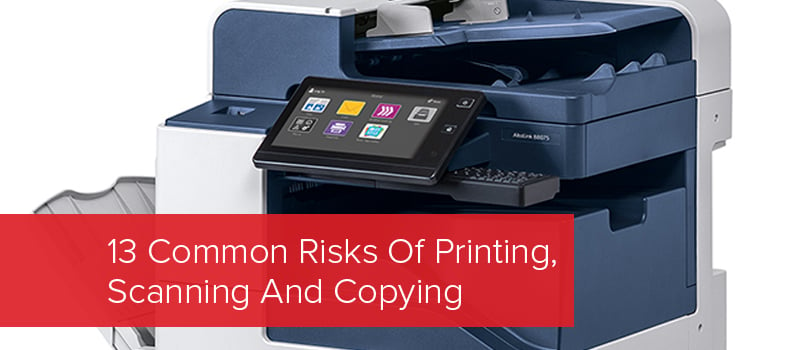Stay up to date with our latest news and insights
Supporting description on the types of content that feature in the blog.

Four years ago, we released a blog about the risks of printing, scanning and copying in a business environment. Despite 4 years of technological innovation, most of these risks are still very relevant today, mainly due to lack of priority assigned to this problem by senior management and the fact that risks are still caused by human interaction and error within these document intensive processes.
“Human error caused 90% of cyber data breaches in 2019” (InfoSecurity Magazine)
It’s true that printing, scanning and copying isn’t always thought of as a security risk. Maybe this is down to it being an everyday business function that doesn’t appear to do anything more than give you a paper version of something or turn a paper document into digital. But what is forgotten is how much sensitive and personal data is on every print, scan or copy, which is traditionally not in scope for data loss prevention (DLP) systems.

With hybrid and remote working now common, technology getting smarter and the processes needing to be adapted for remote working, it has increased the data loss potential gap that printing, scanning and copying processes have had in the past and are subject to more risk now.
In 2020, during the COVID-19 pandemic, there was a huge increase of employees working from home, and with it, Cyfirma reported that their threat visibility and intelligence research showed a 600% increase in cyber threat indicators from February to March 2020.
So what extra data loss measures can organisations adopt to minimise the risks?
As a good place to start with identifying the potential security risks is by reviewing the common risks we have identified and listed below:
Most brands of MFP have the ability to scan to folder, email or fax. If the device is not properly secured, an individual could maliciously or inadvertently email or fax data to an inappropriate recipient. Learn more about keeping your printing processes secure here.
Scanning to USB could be a vulnerability as the information leaves the office network and is outside of its control. USB pen drives or hard discs are very easy to lose due to their portable nature.
USB drives can also carry viruses and the MFD could serve as a point of entry that infects the entire network.
Like any business function, analytics and activity tracking allows you to pick out anomalies and if something does happen, it becomes an easier job to pinpoint what happened, who it was, where it was etc.
Implementing a print management solution can help to track your organisation’s print activity - find out more here.
This just comes down to file management practices - much like putting user permissions in place to access confidential information, it’s important to ensure not everyone can just access stored files and print any document, in case they contain sensitive or personal data.
You can’t just ‘delete’ files, you need to overwrite them and ensure there is no possible way of accessing the data that was previously on the hard drive! You never know who might gain access to it once it’s been removed.
According to the PDF Association, PDF/A is a subset of PDF that eliminates certain risks threatening the one-to-one future reproducibility of the content. The PDF/A format is more resistant to hackers or security breaches because it forbids dynamic content.
Consider how the data for printing transfers to your printer. Now think about the type of data that might be printed by the finance department or HR. What if someone was to intercept the data being sent to the printer? It could be pretty bad. Encryption and network security are there for a reason and should be applied to printing among other digital business functions. Printers are like computers, keeping them secure is crucial!
Unfortunately, unprotected fax connections in multifunction printers can be an open "back door" into the network.
Not only is this bad for the business process as these methods are not audited, so it breaks down the visibility of a document and creates a ‘digital gap’, it also opens up the process to all sorts of vulnerabilities and makes the document harder to track. Which for compliance teams is a real nightmare.
Did you know that human error accounts for 90% of UK data breaches? (InfoSecurity Group) So if people with access to confidential information can do as they wish with the information, how can you stop it being accidentally shared with the wrong person, or left on a train?
Wouldn’t it be useful to know when someone is printing, copying or scanning what’s deemed as confidential information? It’s a great way to track and monitor data that’s being printed and can help stop data breaches.
Even better would be to automatically redact sensitive information - learn how here.
With the rise in hybrid, remote and location free working, it’s possible that employees have been able to print important documents on their home printers or the office printers they have in their home. By using print management software that extends to all devices, whether remote or in the office, it’s possible to track and restrict what people are printing.
Out of date firmware can become a security risk, leaving endpoints open for cyber criminals to access your network and data. It’s best to implement security systems that ensure all devices are automatically updated to the latest firmware version.
If any of the above risks sound familiar in your organisation, it’s time to do something about it. Data breaches are becoming more and more common and while smart devices bring a lot of benefits to the company, they also need to be properly secured to stop data breaches from happening - whether through human error or malicious activity.
The inconvenience of data loss can have even bigger implications for your business when a large amount of data is lost:
Supporting description on the types of content that feature in the blog.

20-09-2024
Digital document management tools offer a range of compelling benefits for businesses, including a PDF editor, a file converter and a form generator. You can also integrate with digital signatures qui...

20-09-2024
When choosing a SaaS software to deal with your company’s PDF documents and enable forms to be digitally sent and signed, you’ll want a product that’s user-friendly and easy to use. With Tungsten’s Po...

11-07-2024
Belkin is a global technology company that provides high-quality electronics products, from wireless chargers to power banks. Their people-centric approach and best-in-class functionality have positio...